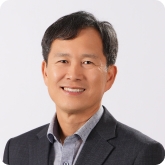- Professor
- Emeritus Professor
- Joint Professor
- Adjunct Professor
- Invited Professors
- Research Professor
Professor Kim, Yong-Hyun (김용현)
2018.09.28 08:51
-

-
Position: Professor/ Associate Vice President of Office of AdmissionsTel&office No: +82-42-350-1111 | E6-6 205호E-mail: yong.hyun.kim(at)kaist.ac.krHomepage: http://qnmsg.kaist.ac.krResearchField: Quantum Materials Simulation / Condensed Matter Theory
Educations
-
2003 Ph.D., KAIST, Physics, 고체물리이론
-
1999 M.S., KAIST, Physics, 초전도이론
-
1997 B.S., KAIST, Physics
Experiences
-
2017~present Professor, GSNT, KAIST2011-2017: Associate Professor, GSNT, KAIST
-
2009~2011 Assistant Professor, GSNT, KAIST
-
2006~2009 Staff Scientist, National Renewable Energy Laboratory, Golden, USA
-
2003~2006 Post-Doc, National Renewable Energy Laboratory, Golden, USA
LAB
QUANTUM nano-bio MATERIALS SIMULATION GROUP
Wecome to KAIST's Quantum Materials Simulation Group (QnMSG) led by Prof. Yong-Hyun Kim since 2009, now permanently settled at Department of Physics. We are performing large-scale ab initio electronic structure calculations and molecular dynamics of nano-bio materials using state-of-the-art supercomputers. Currently, we are interested in fundamental sciences of nanostructured energy materials, graphene/carbon nanotube, nano-bio hybrids, nanocluster/protein melting, finite-temperature thermodynamics, friction, and thermoelectricity.
KAIST 양자물성이론 연구실은 2009년부터 김용현 교수가 이끌고 있고 현재 물리학과와 나노학과에 소속되어 있습니다. 실제 물질에서 일어나는 자연현상을 양자역학과 슈퍼컴퓨터를 이용해 설명하고 예측하는 100% 이론 연구실로서 다양한 실험그룹과 공동연구를 수행하고 있습니다. 연구분야는 반도체 물질, 표면/계면, 나노물질, 에너지물질, 마찰, 열전영상 등입니다.
Research Interest
-
Polar ohmic contact switching with a ferroelectric metal
-
Detecting signatures of surface antibonding nodes through atomic-scale thermopower
-
Thermal biasing for lattice symmetry breaking and topological edge state imaging
-
Molecule-supported magnetic-atom dimers on Au(111): multiple structures and Kondo resonances
-
Pb-free infrared harvesting colloidal quantum dot solar cells using n-p homojunction architecture
-
Surface-originated weak confinement in tetrahedral indium arsenide quantum dots
-
Moisture-controlled triboelectrification during coffee grinding
-
Nanoscale homojunction thermoelectric generator built in defect-engineered MoS2
-
Derivation of a governing rule in triboelectric charging and series from thermoelectricity







